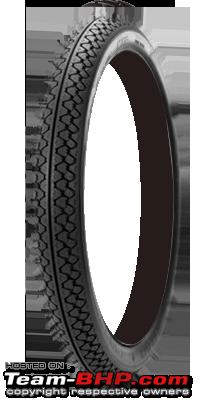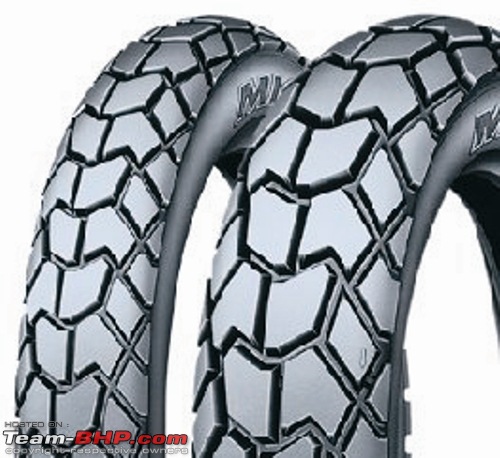
 |
|
Originally Posted by Abeer
(Post 3153168)
Can somebody recommend a good 2.75/18 front tyre for my 4S Champion? |
|
Originally Posted by n_aditya
(Post 3153924)
I used the Michelin M35 on my Fiero's front wheel and highly recommend it. Grip levels are brilliant and life of the tire is good too. Better option is the M45 but not as long lasting as the M35, as per what i have been told. |
|
Originally Posted by petroguzzler
(Post 3154575)
Any reviews on the Ceat Milaze??? My dad had fitted it on the rear wheel of my 2002 Fiero. The grip doesn't seem too effective. |
|
Originally Posted by n_aditya
(Post 3153924)
I used the Michelin M35 on my Fiero's front wheel and highly recommend it. Grip levels are brilliant and life of the tire is good too. Better option is the M45 but not as long lasting as the M35, as per what i have been told. |
|
Originally Posted by Abeer
(Post 3155091)
Is M35 same as Sirac Street? |


|
Originally Posted by Abeer
(Post 3153168)
Can somebody recommend a good 2.75/18 front tyre for my 4S Champion? |
|
Originally Posted by amit_purohit20
(Post 3150712)
|
^^The author is more interested in proving that one should not ride a car tyre in a goldwing motorcycle, which is not important to us. (Kyonki Goldwing sapne mein bhi nahin aati because of its price)
So here are the salient points important to us:
1) First I apologize for putting down few points without doing a proper indepth research (balme it to the lack of time and laziness). I had directly/indirectly stated that for deformable bodies like rubber the friction is also dependent on area due to the simple logic that more the area more the asperities (refer my earlier post for its meaning http://www.team-bhp.com/forum/motorb...ml#post2853071 ). Its true and I am not wrong completely but the contribution due to this factor is marginal and for all practical purposes it can be neglected.
2) So now what dominates the rubber and tarmac contact? Well the ideal friction laws still hold good here. Frictional force= Coefficient of friction x Weight of body.
3) To make things more complex Coefficient of Friciton of Rubber and tarmac changes with respect to pressure. ( I would not like to go into the details now.)
4) If you increase the area of contact by a wider tyre, you also landup reducing the pressure on the contact patch as Pressure= Force/ Area. So the benefits of a wider contact patch is lost because of reduced pressure on the contact patch. This is proved by the research that snow tyres are made less wide to increase the pressure at the contact patch and thus compacting the ice for a better grip.
5) Rubber tyre friction depends on Normal laws of friction, adhesion and rolling resistance. The stickiness of the rubber compound to the tarmac will determine the adhesion.
6) For wet grip its not that only a soft compound will give more friction. Silica (sort of refined sand) is added to the tyre compounds to enhance its wet grip but it reduces other desired properties (dry grip and rolling resistance) of a tyre and hence its a well balanced trade-off. Refinement of silica also plays a major role in enhanced wet grip and so using just any silica sand doesnot help. Cost involved in refinement of silica raises the cost of tyre.
7) The more the depth of the tread grooves (not necessarily the width of the tread groove) is better for pumping water out of the contact patch and thus increasing wet grip.
8 ) Wide tyres have more probability of acquaplanning at least in cars.
So to sum it up its not necessary that a wider tyre will provide more grip than a thinner tyre.
Then why do we have wide tyres and what are the benefits of wide tyres:
1) To increase structural strength of tyres for higher pay load its required to increase the width and other dimensions.
2) One more aspect of having wide tyres is that the manufacturer can add more rubber to it with a softer compound and this extra rubber increases the wear life of the tyre. Otherwise thin soft compound tyres will have worn out easily leaving very less useful tyre life.
3) Wider tyres with higher ply ratings can take up more higher loads.
4) Wider tyres ensure that even in the worst conditions we have some rubber left on the ground.For eg. a tyre going have the way over the curb end. A motorcycle tyre in a high inclination lean.
So practically whats left for a common man after understanding all this tyre gyan:
1) Simply nothing.
2) A buyer can not by anyway understand whats the compound of the tyre and whether its good for wet or dry grip. We can get a vague feeling of the softness/hardness of rubber compound by piercing our nail on the tyre tread and looking for the depth and time required for the tyre to fill it up. But though the rubber may be soft it still may not be the best compound for a wet grip.
3) So we have to bank upon the tyre manufacturers and the actual tyre users ( although they too are vague in their predicaments).
Sorry to say but whatever the tyre study I have done till now has hardly helped me enough to choose a on-road tyre for my requirements. So again the saying " To experience heaven you should die first" :D
PS: I have recently bought a new tyre for the rear wheel of my Apache RTR180.You can soon expect a review for the same.
Disclaimer: All the above points mentioned above is the amalgamation of my research on internet and my engineering common sense which can be wrong.
| All times are GMT +5.5. The time now is 05:07. |